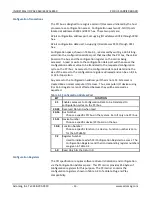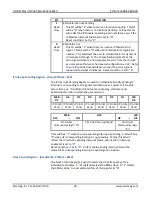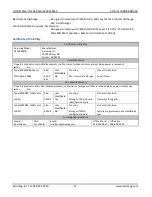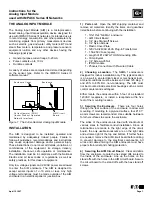
INDUSTRIAL I/O PACK SERIES APCe8650
PCI BUS CARRIER BOARD
Acromag, Inc. Tel: 248-295-0310
- 13 -
www.acromag.com
Configuration Transactions
The PCI bus is designed to recognize certain I/O accesses initiated by the host
processor as a configuration access. Configuration uses two 32-bit I/O ports
located at addresses 0CF8 and 0CFC hex. These two ports are:
32-bit configuration address port, occupying I/O addresses 0CF8 through 0CFB
hex.
32-bit configuration data port, occupying I/O addresses 0CFC through 0CFF
hex.
Configuration space, shown in Table 3-1,, is accessed by writing a 32-bit long-
word into the configuration address port that specifies the PCI bus, the carrier
board on the bus, and the configuration register on the carrier being
accessed. A read or write to the configuration data port will then cause the
configuration address value to be translated to the requested configuration
cycle on the PCI bus. Accesses to the configuration data port determine the
size of the access to the configuration register addressed and can be an 8, 16,
or 32-bit operation.
Any access to the Configuration address port that is not a 32-bit access is
treated like a normal computer I/O access. Thus, computer I/O devices using
8 or 16-bit registers are not affected because they will be accessed as
expected.
Table 3-1 Configuration Address Port
BIT
FUNCTION
31
Enables accesses to Configuration Data to be translated to
configuration cycles on the PCI bus.
30-24
Reserved, Return 0 when read.
23-16
Bus Number
Choose a specific PCI bus in the system. Zero if only one PCI bus.
15-11
Device Number
Choose a specific device/PCI board on the bus.
10-8
Function Number
Choose a specific function in a device. Function number is zero
for the APCe8650
7-2
Register Number
Used to indicate which PCI Configuration Register to access. The
Configuration Registers and their corresponding register numbers
are given in Table 3.2.
1-0
Read Only bits that return 0.
Configuration Registers
The PCI specification requires software driven initialization and configuration
via the Configuration Address space. This PCI carrier provides 256 bytes of
configuration registers for this purpose. The PCI carrier contains the
configuration registers, shown in Table 3-2, to facilitate Plug-and-Play
compatibility.














































